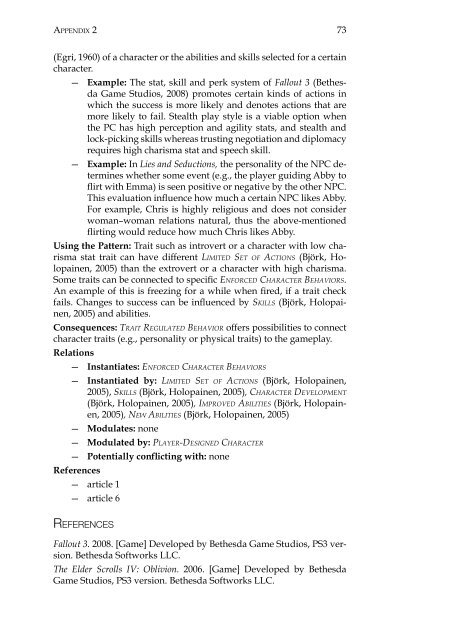Character Driven Game Design
Character Driven Game Design
Character Driven Game Design
You also want an ePaper? Increase the reach of your titles
YUMPU automatically turns print PDFs into web optimized ePapers that Google loves.
Appendix 2 73<br />
(Egri, 1960) of a character or the abilities and skills selected for a certain<br />
character.<br />
——<br />
Example: The stat, skill and perk system of Fallout 3 (Bethesda<br />
<strong>Game</strong> Studios, 2008) promotes certain kinds of actions in<br />
which the success is more likely and denotes actions that are<br />
more likely to fail. Stealth play style is a viable option when<br />
the PC has high perception and agility stats, and stealth and<br />
lock-picking skills whereas trusting negotiation and diplomacy<br />
requires high charisma stat and speech skill.<br />
——<br />
Example: In Lies and Seductions, the personality of the NPC determines<br />
whether some event (e.g., the player guiding Abby to<br />
flirt with Emma) is seen positive or negative by the other NPC.<br />
This evaluation influence how much a certain NPC likes Abby.<br />
For example, Chris is highly religious and does not consider<br />
woman–woman relations natural, thus the above-mentioned<br />
flirting would reduce how much Chris likes Abby.<br />
Using the Pattern: Trait such as introvert or a character with low charisma<br />
stat trait can have different Limited Set of Actions (Björk, Holopainen,<br />
2005) than the extrovert or a character with high charisma.<br />
Some traits can be connected to specific Enforced <strong>Character</strong> Behaviors.<br />
An example of this is freezing for a while when fired, if a trait check<br />
fails. Changes to success can be influenced by Skills (Björk, Holopainen,<br />
2005) and abilities.<br />
Consequences: Trait Regulated Behavior offers possibilities to connect<br />
character traits (e.g., personality or physical traits) to the gameplay.<br />
Relations<br />
——<br />
Instantiates: Enforced <strong>Character</strong> Behaviors<br />
——<br />
Instantiated by: Limited Set of Actions (Björk, Holopainen,<br />
2005), Skills (Björk, Holopainen, 2005), <strong>Character</strong> Development<br />
(Björk, Holopainen, 2005), Improved Abilities (Björk, Holopainen,<br />
2005), New Abilities (Björk, Holopainen, 2005)<br />
——<br />
Modulates: none<br />
——<br />
Modulated by: Player-<strong>Design</strong>ed <strong>Character</strong><br />
——<br />
Potentially conflicting with: none<br />
References<br />
——<br />
article 1<br />
——<br />
article 6<br />
References<br />
Fallout 3. 2008. [<strong>Game</strong>] Developed by Bethesda <strong>Game</strong> Studios, PS3 version.<br />
Bethesda Softworks LLC.<br />
The Elder Scrolls IV: Oblivion. 2006. [<strong>Game</strong>] Developed by Bethesda<br />
<strong>Game</strong> Studios, PS3 version. Bethesda Softworks LLC.
















